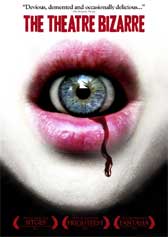 THE
THEATRE BIZARRE (2011)
THE
THEATRE BIZARRE (2011)Directors: Richard Stanley, Buddy Giovinazzo, Tom Savini, Douglas
Buck, Karim Hussain, David Gregory and Jeremy Kasten
Image Entertainment/W2 Media
 THE
THEATRE BIZARRE (2011)
THE
THEATRE BIZARRE (2011)Out on DVD from Image Entertainment, the Severin Films anthology THE THEATRE BIZARRE showcases six short horror tales from the likes of Richard Stanley (DUST DEVIL), Buddy Giovinazzo (COMBAT SHOCK), Tom Savini (the 1990 remake of NIGHT OF THE LIVING DEAD) and David Gregory (PLAGUE TOWN) among others.
In the framing story – to use the term loosely – “Theatre Guignol” (directed by Jeremy Kasten [THE WIZARD OF GORE remake]), Penny (Virginia Newcomb, MACHETE JOE) enters an abandoned theater where a marionette-like host (Udo Kier, of course) directs her attention to six stories:

In Richard Stanley’s “Mother of Toads” anthropologist Martin (Shane Woodward) and his girlfriend Karina (Victoria Maurette, LEFT FOR DEAD) are vacationing in the French Pyrenees. At a street market, they come across the table of Mere Antoinette (Catriona McColl, THE BEYOND) and Martin recognizes H.P. Lovecraft’s Elder Symbol on a pair of earrings that Karina tries on. Mere Antoinette tempts Martin into visiting her cottage with the promise of a real copy of the Necronomicon while Karina lounges poolside at a nearby spa. Martin is fascinated by the book, but Mere Antoinette’s interests in him are less than scholarly, and he and his curious girlfriend are about to have very sticky encounters – of different sorts – with the titular beast.
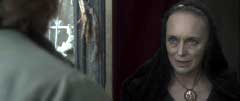 Based
on Clarke Ashton Smith’s very short story, Stanley’s adaptation
is actually pretty faithful to the source; however, it is a rather inauspicious
return to the genre by the South African director of HARDWARE and DUST DEVIL.
It changes the era, the protagonist, gives a victim fodder girlfriend, and throws
in some explicit Lovecraft references (the author was a major influence on Smith’s
writing). Whether Stanley was constrained by the running time requirement or
the slight source material, but it feels like a very short MASTERS OF HORROR
episode directed by Richard Stanley, and not a very personal one at that. At
best, it feels like Stanley exercising his directorial aesthetics – although
he has directed a handful of documentaries and scripted THE ISLAND OF DR. MOREAU
(which he was also to have directed), Nacho Cerda’s THE ABANDONED (with
“Mother of Toads” cinematographer Karim Hussain) as well as Cerda’s
forthcoming horror comic adaptation I AM LEGION – as a rehearsal for something
more substantial (possibly his proposed feature adaptation of Arthur Machen’s
“The Great God Pan”?). McColl gives it a good try (and she’s
just as obviously “sinister” as the unsubtle character in the story),
but there’s not enough time to adequately shape Woodward’s character’s
scholarly fascination (and spends a good deal of the segment’s running
time devoted to a generic stalking sequence featuring Maurette). On the commentary
track, Hussain (SUBCONSCIOUS CRUELTY) – who shares the segment’s
track with Stanley, Maurette, and producer Fabrice Lambot (Woodward was also
supposed to participate) – comments on the colored lighting’s debt
to Dario Argento; however, the Red One digital photography is more MOTHER OF
TEARS than SUSPIRIA, and nowhere near as intoxicating as what Stanley achieved
with D.P. Steven Chivers on HARDWARE and DUST DEVIL. For fans of Stanley’s
feature work “Mother of Toads” also signifies his reunion with composer
Simon Boswell (who also scored Hussain’s entry “Vision Stains”);
but Boswell actually has scored all of Stanley’s documentaries: VOICE
OF THE MOON (1990), THE SECRET GLORY (2001), and THE WHITE DARKNESS (2002).
Based
on Clarke Ashton Smith’s very short story, Stanley’s adaptation
is actually pretty faithful to the source; however, it is a rather inauspicious
return to the genre by the South African director of HARDWARE and DUST DEVIL.
It changes the era, the protagonist, gives a victim fodder girlfriend, and throws
in some explicit Lovecraft references (the author was a major influence on Smith’s
writing). Whether Stanley was constrained by the running time requirement or
the slight source material, but it feels like a very short MASTERS OF HORROR
episode directed by Richard Stanley, and not a very personal one at that. At
best, it feels like Stanley exercising his directorial aesthetics – although
he has directed a handful of documentaries and scripted THE ISLAND OF DR. MOREAU
(which he was also to have directed), Nacho Cerda’s THE ABANDONED (with
“Mother of Toads” cinematographer Karim Hussain) as well as Cerda’s
forthcoming horror comic adaptation I AM LEGION – as a rehearsal for something
more substantial (possibly his proposed feature adaptation of Arthur Machen’s
“The Great God Pan”?). McColl gives it a good try (and she’s
just as obviously “sinister” as the unsubtle character in the story),
but there’s not enough time to adequately shape Woodward’s character’s
scholarly fascination (and spends a good deal of the segment’s running
time devoted to a generic stalking sequence featuring Maurette). On the commentary
track, Hussain (SUBCONSCIOUS CRUELTY) – who shares the segment’s
track with Stanley, Maurette, and producer Fabrice Lambot (Woodward was also
supposed to participate) – comments on the colored lighting’s debt
to Dario Argento; however, the Red One digital photography is more MOTHER OF
TEARS than SUSPIRIA, and nowhere near as intoxicating as what Stanley achieved
with D.P. Steven Chivers on HARDWARE and DUST DEVIL. For fans of Stanley’s
feature work “Mother of Toads” also signifies his reunion with composer
Simon Boswell (who also scored Hussain’s entry “Vision Stains”);
but Boswell actually has scored all of Stanley’s documentaries: VOICE
OF THE MOON (1990), THE SECRET GLORY (2001), and THE WHITE DARKNESS (2002).
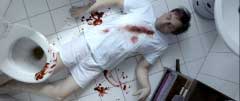
COMBAT SHOCK’s Buddy Giovinazzo helms the Polanski-esque “I Love You” in which Mo (Suzan Anbeh, FRENCH KISS) pans to leave her drunken, co-dependent husband Axel (André Hennicke, A DANGEROUS METHOD) for another man (Harvey Friedman, VALKYRIE). Mo gives Axel every reason for him to be glad to be rid of her (multiple affairs, one night stands, a secret abortion of a child that might have been his); so much so, that Axel goes from angry to disbelieving. The ending is one of overused sudden twists of the protagonist’s false perception that reveals the supposedly shocking truth (and one good gore effect). On the commentary track, Giovinazzo – who is now living in Berlin, where the story is set – says that he wrote the script with the two lead actors in mind. While it might not have made a traditional horror film, a feature-length look at the relationship of these two characters being horrible to one another might have been more interesting.
 In
Tom Savni’s “Wet Dreams”, philandering brute Donnie (James
Gill) has nightmares involving castration and his put-upon wife (B scream queen
Debbie Rochon, TROMEO AND JULIET). He seeks help from a therapist (Savini),
but his suggested relaxation methods seem to blur the lines of reality between
Donnie’s nightmare world and his everyday life. The episode is more concerned
with shock images of castration – no longer taboo in mainstream film thanks
to the whole “torture porn” wave – and whatever “Freudian”
analysis the audience can read into said images. Think of this one as an unrated
TALES FROM THE CRYPT episode with an obvious twist. On the commentary track,
Savini mentions that the crotch monster prop was created by and given freely
to him by effects artist Greg Nicotero (Savini shares the track with producers
Michael Ruggiero and Robert Lucas).
In
Tom Savni’s “Wet Dreams”, philandering brute Donnie (James
Gill) has nightmares involving castration and his put-upon wife (B scream queen
Debbie Rochon, TROMEO AND JULIET). He seeks help from a therapist (Savini),
but his suggested relaxation methods seem to blur the lines of reality between
Donnie’s nightmare world and his everyday life. The episode is more concerned
with shock images of castration – no longer taboo in mainstream film thanks
to the whole “torture porn” wave – and whatever “Freudian”
analysis the audience can read into said images. Think of this one as an unrated
TALES FROM THE CRYPT episode with an obvious twist. On the commentary track,
Savini mentions that the crotch monster prop was created by and given freely
to him by effects artist Greg Nicotero (Savini shares the track with producers
Michael Ruggiero and Robert Lucas).
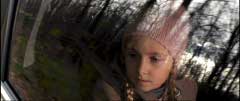
The tone changes entirely for “The Accident” by Douglas Buck (the remake of Brian DePalma’s SISTERS), in which a mother (Lena Kleine, TERRITORIES) tries to explain why people die to her daughter (Mélodie Simard) after they witness a gory road accident between two bikers and a deer. Although it contains some gore, the story is more of a mood piece and rather ill-fitting to the “guignol” concept; however, that doesn’t mean that it isn’t worth watching. Unlike the other episodes, no commentary was supplied by the director (who does appear on the commentary track for the following story).
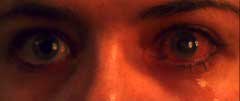 In
Karim Hussain’s “Vision Stains” a vagrant woman (Kaniehtiio
Horn, THE WILD HUNT) kills destitute women and extracts fluid from their eyeballs,
which she injects into her own eye to see the life that flashing by. In extremely
redundant narration, she claims to be a voice for these women, preserving their
stories (although it looks like a very peculiar kind of drug fix). Things take
an even gorier turn when she decides she wants to see the life of something
that has not yet lived. Overuse of narration and voiceovers that spell out what
is extremely obvious ruin what might have been an effective “silent”
film; as if Hussain were afraid that something of his concept would be lost
by condensing a longer story, or perhaps he just wanted to give actress Horn
a vocal aspect to her performance. A character like this doesn’t have
to face moral consequences to learn a moral; but, once again, what is already
obvious from the final shots is given to us in voiceover. As mentioned above,
Hussain (who photographed “The Accident”) is joined by “The
Accident” director Buck (who edited “Vision Stains”) as well
as actress Horn.
In
Karim Hussain’s “Vision Stains” a vagrant woman (Kaniehtiio
Horn, THE WILD HUNT) kills destitute women and extracts fluid from their eyeballs,
which she injects into her own eye to see the life that flashing by. In extremely
redundant narration, she claims to be a voice for these women, preserving their
stories (although it looks like a very peculiar kind of drug fix). Things take
an even gorier turn when she decides she wants to see the life of something
that has not yet lived. Overuse of narration and voiceovers that spell out what
is extremely obvious ruin what might have been an effective “silent”
film; as if Hussain were afraid that something of his concept would be lost
by condensing a longer story, or perhaps he just wanted to give actress Horn
a vocal aspect to her performance. A character like this doesn’t have
to face moral consequences to learn a moral; but, once again, what is already
obvious from the final shots is given to us in voiceover. As mentioned above,
Hussain (who photographed “The Accident”) is joined by “The
Accident” director Buck (who edited “Vision Stains”) as well
as actress Horn.

Finally, in David Gregory’s “Sweets” mismatched couple Estelle (Lindsay Goranson, THE POPCORN MAN) and Greg (Guilford Adams, EQUINOX KNOCKS) take the “joys of mastication” to grotesque extremes; but one of them takes it one step further… SHIVERS’ Lynn Lowry has a small role, and is a bright spot in a somewhat predictable story. Gregory goes solo on the commentary track for this one, and mentions that the film’s candy-coated color scheme was conceived to evoke the colors and textures of vomit. “Sweets” may be the only one of the episodes that truly belongs in not only in a film called THE THEATRE BIZARRE, but also may be the only one truly appropriate to the wraparound “Theatre Guignol” concept. As such, Kier’s scripted introductions to each story are very vague and really add nothing to ones appreciation of any of them. It should go without saying that the ending to Kasten’s wraparound is also entirely predictable. As a whole, THE THEATRE BIZARRE probably goes over better when screened for a crowd than when watched in any kind of home theater; and individual stories may be of more interest to various viewers’ tastes than the film as a whole.
 All
six of the films and the wraparound segments were photographed in high definition,
and Image’s dual-layer disc probably represents the feature as well as
it can in SD (especially when it shares the same disc with about 50 minutes
of extras). There are some blown-out highlights and some distortion during the
wrap-around segments, but that is more likely a fault of the cinematography
than the encoding. The enveloping nature of the Dolby Digital 5.1 audio varies
from episode to episode depending on the tastes of the filmmakers and the requirements
of the stories. Besides the aforementioned filmmakers’ commentary track,
there are very short behind-the-scenes segments for five of the episodes (including
Kasten’s wraparound) that run between one to two minutes each, and “Shock
‘til You Drop” interviews with Gregory (15:03), Giovinazzo (10:25),
and Kasten (12:51). A theatrical trailer for the feature (1:35) is also included.
(Eric
Cotenas)
All
six of the films and the wraparound segments were photographed in high definition,
and Image’s dual-layer disc probably represents the feature as well as
it can in SD (especially when it shares the same disc with about 50 minutes
of extras). There are some blown-out highlights and some distortion during the
wrap-around segments, but that is more likely a fault of the cinematography
than the encoding. The enveloping nature of the Dolby Digital 5.1 audio varies
from episode to episode depending on the tastes of the filmmakers and the requirements
of the stories. Besides the aforementioned filmmakers’ commentary track,
there are very short behind-the-scenes segments for five of the episodes (including
Kasten’s wraparound) that run between one to two minutes each, and “Shock
‘til You Drop” interviews with Gregory (15:03), Giovinazzo (10:25),
and Kasten (12:51). A theatrical trailer for the feature (1:35) is also included.
(Eric
Cotenas)